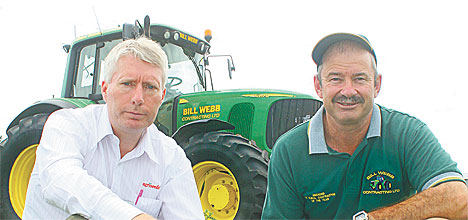Farmers should leave cows on pasture for only two hours in order to not over-graze paddocks.
Agriseeds technical development manager Graham Kerr told farmers at a Bill Webb Contracting field day, they should be putting cows on pasture first, for two hours, then put them on a crop and feed out any further supplements there.
Graham says only the top 20 per cent of farmers have good pasture renovation plans in place.
'The thing we don't get right is how hard we graze.
'In an extended dry period if you leave them on the grass they mash the pasture stubble.”
He says the cows trample the grass reserves and driving a tractor and feed-out wagon with supplement over the paddocks is trampling the pasture further.
'Feed out silage on a crop – it's better to sacrifice that, or your worst paddock on the farm.”
He says farmers have to do this in order to protect the grass reserves above the ground.
'A lot of people think the grass reserve is below the ground.
'The reserve is in the base of the stem, the stubble. It's really important for re-growth. Over-grazing is grazing into the stubble.”
The three summer stresses are drought, insects and over-grazing says Graham.
'You can't control the first two, you can control the over-grazing.”
Graham says the first leaf a rye grass plant puts up acts as a solar panel, getting the energy to put up the second leaf. He says the time a plant takes to put up one leaf is about seven days, but can take up to 10-15 in the summer.
That is why farmers need to extend their rotation to 35-40 days says Graham.
'It's hard when there's no grass. Don't graze pasture below four centre metres or seven clicks on the RPM (rural plate meter).
'Dry matter increases in summer. In summer we often go down to six, to five, to four clicks – affecting growth and resistance.”
He says for the survival of the pasture, 'if you can keep the reserves up a bit, you will maximise persistence of survival”.
He says with the old endophyte the cows wouldn't eat the stubble, but they do now.
The stocking rate is also crucial to not over-grazing.
'If we are going to continue to have these dry summers, we are going to be over-stocked.”
He says farmers need to make decisions early on culling, milking once-a-day and growing and buying in supplements.
About 40 farmers attended the pasture renovation field day hosted by Bill Webb Contracting at the Paengaroa North B10A dairy farm in Te Puke.
Lower order sharemilker John Fourie milks 375 Friesian/Friesian crossbreds on 137 hectares, with a designated five hectare maize block.
On top of that he grows four hectares of turnips and eight hectares of chicory as part of the annual pasture renovation programme.
Grass production must be a priority for farmers in order to aim for high production, says Bill.
'You should be putting new pasture in 10-15 per cent of your farm every year, so you work towards replacing the pasture over the whole farm every decade.”
Bill says farmers should select the worst paddocks for the pasture renovation programme to get 'more bang for your buck.”
Farmers need to be cultivating or under-sowing rundown pastures for extra feed, and address fertility, weeds, pests, and the correct variety of clover and rye to suit the farm needs.
Bill says farmers should select paddocks for renovation early and put in an annual crop to grow a high quantity and high quality feed, for winter and spring.
He says the five to seven tonnes dry matter/ha you will get from the crop will be more than what you get off your tired pasture.
Bill says farmers should graze three to five days post spraying, and then do drainage and contouring before putting on lime, then disc, then apply the required base fertiliser, and leaving that five to seven days before power-harrowing and planting as it can burn seed.
'When sowing, we use a roll seed roller, and roll, roll, roll. That is the best practice on our light (Bay of Plenty) soil.
'Sowing with a roller maintains an even depth for the seed, 10-15mm depth.”
Bill says they can come and monitor the paddocks after sowing.
'We can do this for you free of charge.”
He says monitoring is important in the control of weeds and insects.
'We often go back to see if farmers want to spray for weeds – 'no no, the grass seems to be growing”.
'Less than a quarter of farmers would spray and they should,” says Bill, 'just prior to first grazing but check that the new grass is well anchored before grazing, preferably with young stock, then apply urea which promotes quick recovery and tillering, then maintain a good fertiliser programme as you only get out of it what you put in”.
Bill says their team will 'make sure your pastures are doing the job they need to. We'll start with analysing your soil, fertilising, cultivating, or re-levelling and sowing new pest and disease resistant varieties.
'We're here to help you succeed.”



0 comments
Leave a Comment
You must be logged in to make a comment.